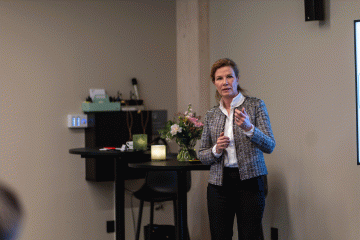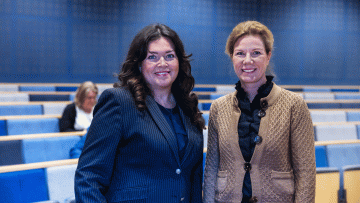COLLABORATION. The development of life science in Western Sweden is strategically driven by collaboration between universities, industry, and healthcare. During a study visit by Minister of Social Affairs Jakob Forssmed and Jeanette Edblad, Head of the National Life Science Office, representatives from institutions such as Sahlgrenska Academy at University of Gothenburg, Sahlgrenska University Hospital, Chalmers University of Technology, AstraZeneca, and GoCo Health Innovation City presented the long-term vision for cooperation.

“We have a common drive forward, contributing to lifting the entire country within life science. It’s an exciting and growing sector. One of the key success factors here in Western Sweden is the strong expertise we are building through education and research,” says Jenny Nyström, Dean of Sahlgrenska Academy at the University of Gothenburg.
The investment in the national infrastructure CCRM Nordic also strengthens Sweden as a knowledge nation within life science. Together with Oligonova, this provides better opportunities for the development, manufacturing, and commercialization of gene, cell, and tissue therapies. During the two-day meeting in Gothenburg, visitors had the chance to see one of the cleanrooms where advanced therapy medicinal products (ATMPs) are manufactured.
Collaborations with other universities

The study visit began on a rainy Tuesday afternoon at Sahlgrenska University Hospital. Here, representatives from Sahlgrenska University Hospital, Chalmers University of Technology, and the Sahlgrenska Academy discussed how they collectively contribute to strengthening Sweden as a leading life science nation. Boubou Hallberg, hospital director at Sahlgrenska University Hospital, suggested that given the proximity between the university hospital, the technical university, the university, and the life science industry, Gothenburg should no longer be called “little London” but instead compared to Boston, where so much important research is concentrated.
“Within a mile’s radius, Gothenburg has everything from AI centers and industrial clusters to research, education, and specialized healthcare with 1.4 million patient visits per year,” said Boubou Hallberg. “So perhaps we should call ourselves ‘little Boston’ instead.”
Jenny Nyström, professor and dean at the Sahlgrenska Academy, had the opportunity to talk about research at the University of Gothenburg and highlighted the close collaboration with other universities.
“This includes basic research together with Chalmers University of Technology and work in health economics together with the School of Business, Economics and Law.”
ATMP up close

There was also a visit to the Cell and Tissue Laboratory within the Clinical Immunology and Transfusion Medicine department. Jan Holgersson, professor and vice dean at Sahlgrenska Academy, showed one of the cleanrooms where the hospital manufactures advanced therapy medicinal products (ATMPs) and discussed progress and challenges in the field.
In the meticulously controlled premises, T-cells, known as tumor-infiltrating lymphocytes, are manufactured, which are used in clinical studies for the treatment of ocular melanoma.
“It’s incredibly important that we have the right infrastructure and functional premises,” emphasized Jan Holgersson. “Maintaining premises for pharmaceutical production is both personnel-intensive and technically demanding.”
One of the challenges in the field mentioned by Jan Holgersson is competence supply, where it can sometimes be difficult to find individuals with the right profile, requiring internal training to provide individuals with the specific competencies needed for manufacturing ATMPs in a hospital environment. In the future, it may also involve finding solutions where one person holds a position shared between healthcare and academia or industry.
The importance of the right competencies
Another major challenge revolves around the regulations surrounding the activity in general and the in-house manufacturing of advanced therapy medicinal products specifically.
“If an ATMP product is not commercially viable, will it then become the responsibility of healthcare to manufacture it to meet the needs of the relevant patient group?” commented Jan Holgersson.

Jeanette Edblad, Head of the National Life Science Office, had many thoughts after listening to the various presentations.
“There is a need for collaboration between the technology sector and traditional life science, and as many discussed during their presentations, it’s important to have the right competencies for the transition within the life science sector.”
“It was exciting to hear about how Western Sweden is at the forefront with a long-term vision; there is a strategic way of thinking here,” concluded Jeanette Edblad before the visit to Western Sweden continued to other life science stakeholders.
BY: PATRIK CENTERWALL (SAHLGRENSKA UNIVERSITY HOSPITAL) & ELIN LINDSTRÖM (SAHLGRENSKA ACADEMY)
PHOTO: GOCO HEALTH INNOVATION CITY AND SAHLGRENSKA UNIVERSITY HOSPITAL (PAUL BJÖRKMAN)












Leave a Comment